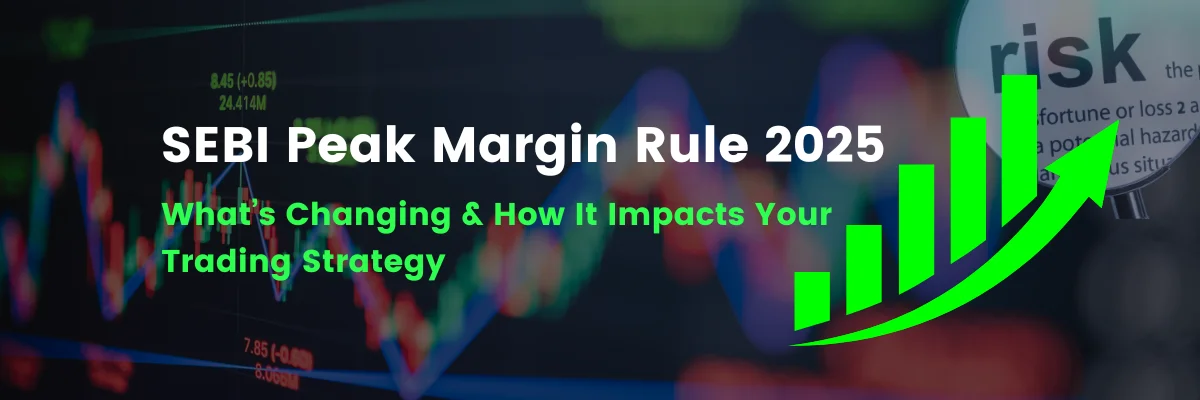The SEBI Peak Margin Rule has been one of the biggest shifts in India’s trading ecosystem. While our earlier blog covered the foundations, this update dives into the latest changes, emerging practices, and what investors should prepare for year ahead.
If you actively trade in intraday, cash, or F&O, understanding the SEBI peak margin rule 2025 India is critical—not just for compliance, but for smarter trading decisions.
🔄 Quick Refresher: What Is the Peak Margin Rule?
The SEBI peak margin rule requires brokers to collect the highest margin demanded during the trading day, not just the closing margin. This ensures traders maintain margins throughout the day, reducing the risk of excessive leverage.
In simple words:
Whatever your highest intraday exposure is, that’s the margin SEBI expects you to maintain.
This applies across:
- Cash segment
- Intraday trades
- Derivatives (F&O)
Many traders still Google: “What is peak margin in trading India?” — because they feel the pinch when their intraday positions suddenly demand more margin. This update clears that confusion.
📈 What’s New in the Peak Margin Framework (2024–2025)
Here are the most relevant updates affecting traders today:
1️⃣ 100% Upfront Margin Is Now the Norm
Unlike earlier phases, the rule is now in full enforcement, meaning there’s no relaxation on margin collection.
This directly impacts traders searching for:
- “SEBI peak margin rule explained for F&O”
- “SEBI peak margin shortfall penalty 2025”
2️⃣ BOD (Beginning of Day) Rate Framework Is Getting Stronger
The new SEBI peak margin framework BOD rates helps brokers assess your margin requirement right at the start of the day — preventing gaps and margin shortfalls.
3️⃣ Intraday Leverage Is Now Tighter Than Ever
If you're looking for “SEBI peak margin rule intraday leverage reduction India”, here's the answer: Leverage is lower, and brokers cannot offer high intraday boosts.
4️⃣ Cash vs Derivatives Clarifications
Many traders still wonder about the peak margin requirement in cash segment India vs F&O.
✔ Cash segment demand is rising due to tighter compliance.
✔ F&O remains highly margin-sensitive with rapid snapshot checks.
5️⃣ Penalty Structure Has Become Stricter
The penalties for peak margin shortfall under SEBI norms now trigger quicker and more aggressively.
🎯 What These Changes Mean for You as a Trader (Especially in 2025)
This is where the rule impacts your actual trading choices:
✔ Maintain a Margin Buffer – Always
Because SEBI tracks your peak exposure, having buffer funds is essential.
Traders searching for “how to comply with SEBI peak margin rule as trader” will find this advice crucial.
✔ Re-think High-Leverage Intraday Strategies
The new norms have changed the game.
If you're someone who depended on leverage, consider switching to:
- Lower-risk setups
- Clearly defined SL (stop loss) plans
- Smaller but consistent position sizing
✔ Be Ready for Dynamic Margin Calls
You may receive alerts whenever your exposure jumps. Missed alerts can trigger penalties.
✔ Delivery Traders Are Affected Too
It’s not only intraday. Even delivery traders can face penalty if the peak exposure temporarily exceeds available margin.
🛠 Practical Trading Tips Under the SEBI Peak Margin Rule 2025
Use these to stay compliant and avoid unnecessary losses:
- Check margin availability before initiating intraday and F&O positions.
- Keep at least 10–15% buffer above your expected margin needs.
- Avoid using unsettled funds for fresh trades without margin verification.
- Square-off intraday trades early if you're near a margin shortfall.
- Monitor peak exposure manually even if your system doesn’t show it in real time.
- If trading in options, be mindful of large fluctuations that cause sudden margin spikes.
📌 Why SEBI Introduced the Peak Margin Rule
The regulatory intention behind:
“Why SEBI introduced the peak margin rule trading India”…is simple:
✔ create a safer market ecosystem
✔ reduce excessive leverage
✔ prevent broker-funded intraday speculation
✔ protect retail traders from over-exposure
🤝 How GEPL Capital Helps You Stay Compliant
If you're searching for:
- “How GEPL Capital helps clients comply with SEBI peak margin”…here’s what we offer:
GEPL Advantage:
- Real-time margin monitoring
- Timely alerts for top-ups
- Margin calculators
- App-based notifications
- Relationship Manager support
- 100% transparent margin display
- No hidden charges or sudden deductions
GEPL ensures that you always know your margin requirement before and during your trades.
📚 Frequently Asked Questions
1️⃣ What is the difference between peak margin and end-of-day margin in India?
Peak margin = highest exposure during the day
EOD margin = margin on your final position
✔ SEBI enforces peak margin, not just EOD.
2️⃣ What happens if I don’t maintain peak margin?
You may face penalties under the SEBI peak margin shortfall penalty 2025 norms.
3️⃣ Does peak margin apply to both cash and F&O?
Yes — though the impact is more volatile in derivatives.
4️⃣ Has SEBI given relaxation for 2025?
No — the rule is fully implemented with stricter BOD checks.
💡 Bottom Line: Adapt Your Strategy, Strengthen Your Discipline
The SEBI peak margin rule 2025 isn’t designed to restrict traders—it encourages responsible and safer trading.
As a GEPL Capital client, you are equipped with the right tools, alerts and expert support to navigate this rule confidently.
Margin isn’t just a compliance requirement anymore—👉 It’s a core part of your trading strategy.
📞 Need Assistance? We're Here to Help.
For queries, reach out at:
📧 support@geplcapital.com | 📞 022 31019911
💬 WhatsApp Support Bot – 24/7 Help Centre
Disclaimer:
Investments in the securities market are subject to market risk. Read all related documents carefully before investing.
This communication is for informational and educational purposes only and does not constitute investment advice or a recommendation. Please do your own research and consult a qualified financial advisor before making any investment decisions.








